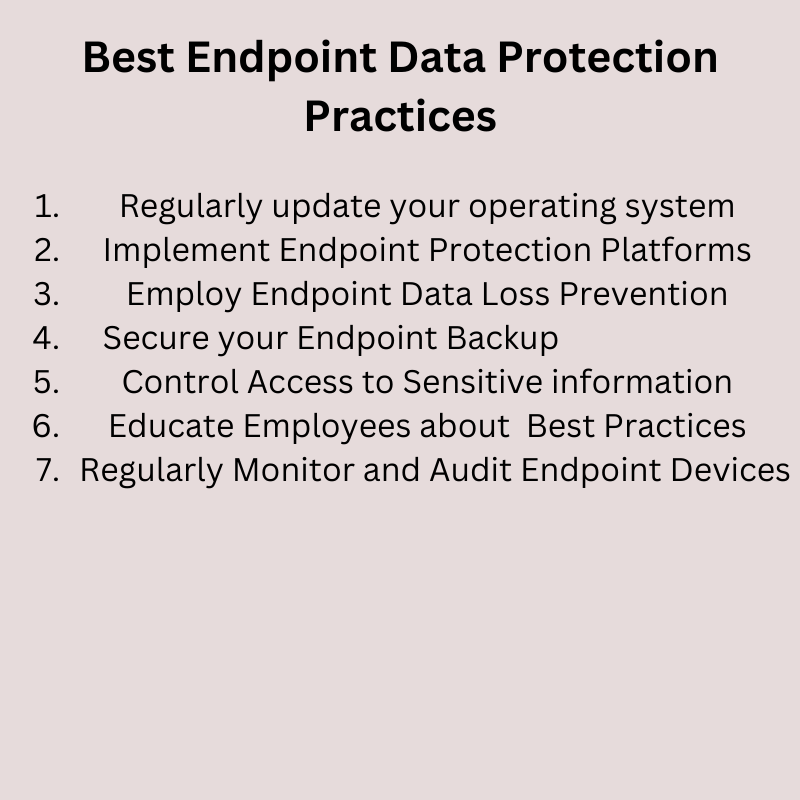
DLP Demystified: Why Small Businesses Can’t Afford to Ignore Data Loss Prevention
Today, data security is not just a luxury, it’s a necessity. As a small business manager, you may not be a cybersecurity expert. However, understanding the basics of Endpoint Data Loss Prevention (DLP) can help. DLP can protect your business from data leaks and unauthorized access.
DLP is a set of tools and processes designed to prevent the loss, misuse, or unauthorized access of sensitive information. It’s like a virtual security guard, constantly monitoring and protecting your business-critical data.
Key Takeaways
- Proactive Monitoring: Endpoint DLP solutions continuously monitor data at rest, in use, and in motion, helping detect and prevent potential data breaches before they occur.
- Access Control: Effective DLP includes managing who has access to sensitive information, using strong passwords and restricting access to prevent unauthorized users from compromising your data.
- Cloud-Based Solutions: Cloud-based DLP tools offer a flexible and cost-effective way to protect sensitive data stored in cloud services, making them ideal for small businesses transitioning to the cloud.
- Comprehensive Protection: Different types of DLP solutions (Endpoint, Network, and Storage) address various data protection needs, ensuring that businesses can secure their data across all potential points of vulnerability.
By implementing these strategies, small businesses can better protect their sensitive data and ensure compliance with data protection regulations.
The Hidden Threats: Understanding the Types of Data at Risk in Your Business
Every business, regardless of its size, handles a variety of data types. This includes Personally Identifiable Information (PII) like customer names and contact details. It also includes sensitive information such as financial records. Another often overlooked asset is intellectual property. This includes anything from your business strategies to proprietary software. All these types of data can be attractive targets for cybercriminals, and losing them can have serious consequences.
Endpoint Data Loss Prevention: Your Business’s Secret Weapon Against Data Loss
DLP isn’t just about responding to threats, it’s about preventing them. By continuously monitoring data in use, in motion, and at rest, DLP tools can detect potential data breaches before they occur. This proactive approach is why DLP adoption is becoming increasingly common. It’s a game-changer that can give you peace of mind and let you focus on what you do best: running your business.
Guarding the Gates: Managing Unauthorized Users in Your Business
A key part of DLP is managing who has access to your data. This is where your security team comes in. Your “security team” may just be one person. However, they still play a crucial role in controlling access to your data. Thus, preventing unauthorized users from gaining access. This includes everything from setting strong passwords to restricting access to sensitive info
Embracing the Cloud: The Power of Cloud-Based Endpoint Data Loss Prevention Solutions
Cloud-based DLP solutions protect data stored in the cloud. They can classify and protect sensitive data across various cloud services. These services include cloud storage, email, and SaaS applications. These tools can:
- enforce data protection policies
- prevent unauthorized sharing of data
- provide visibility into your cloud data.
Cloud-based DLP solutions offer several benefits for small businesses. They are typically easier to implement and manage than on-premises solutions. Cloud-based DLP can provide protection for data no matter where it is located. This is true whether the data is on cloud-based servers and applications. This means you can secure your sensitive data, wherever it is.
More small businesses are moving their operations to the cloud. As this happens, cloud based DLP solutions are becoming increasingly important. They ensure that your business’s data is protected no matter where it’s stored. These DLP solutions can adapt to the changing security challenges of the cloud environment.
Navigating the Data Loss Prevention Landscape: Understanding the Different Types of Endpoint Solutions
There are several types of DLP solutions available, including Network DLP, Endpoint DLP, and Storage DLP. Each type has its strengths and is suited to different kinds of data and business needs. Understanding these differences can help you choose the right DLP tool for your business.
Endpoint Data Loss Prevention Solutions
Endpoint DLP solutions focus on protecting data at the user level. They monitor and control data activity on all user devices, including desktops, laptops, tablets, and mobile phones. These tools can detect and block unauthorized attempts to copy, transfer, or send sensitive data. They can also enforce data protection policies. For instance, preventing certain types of data from being sent via email or uploaded to cloud storage. For a small business, an endpoint DLP solution is crucial because it provides control over how data is used and shared by employees. This is particularly important in today’s remote work environment. Today, employees may be using unsecured networks or personal devices to access business data.
Network DLP Solutions
Network DLP solutions monitor and protect data in motion on your business’s network. They can detect sensitive data being sent over the network. This is true whether it’s via email, web uploads, instant messaging, or other data transfer methods. If the tool detects an unauthorized data transfer, it can block the transfer and alert your security team. Small businesses need network DLP solutions. These solutions can protect against both internal and external threats. For example, an employee might accidentally send sensitive data to the wrong person. In another example, a cybercriminal might try to exfiltrate data from your network. A network DLP solution can prevent these types of data leaks.
Storage DLP Solutions
Storage DLP solutions focus on protecting data at rest. This includes data stored on:
- network servers
- databases
- file servers,
- other storage devices within your organization.
These solutions can identify and classify sensitive data. Further, they monitor access to this data, and enforce data protection policies. Thus, they prevent unauthorized access or data leaks. For small businesses, a storage DLP solution is essential. It helps to secure data within the organization’s premises. It provides an added layer of security by ensuring that sensitive data remains secure even when it’s not in transit or in use.
The CISO’s Role in Data Loss Prevention: Why Every Small Business Manager Should Know This
Even if your business doesn’t have a Chief Information Security Officer (CISO), it’s important to understand the role they play in DLP. CISOs are responsible for overseeing a company’s data security strategy, including DLP. They can provide valuable insights into how to improve your data security and prevent data loss.
DLP Implementation: A Practical Guide for Small Businesses
Implementing a DLP solution may seem daunting, but it doesn’t have to be. There are many resources available to help you choose and implement a DLP solution that fits your business’s needs. Remember that DLP isn’t just about protecting your data. DLP is also about ensuring your business complies with data protection regulations.
DLP in Real Life: Case Studies of Data Loss Prevention Saving Small Businesses
Data Loss Prevention (DLP) tools have proven to be lifesavers for many small businesses. Here are a few real-life case studies that illustrate the importance and effectiveness of DLP solutions:
Preventing Accidental Data Exposure
A small healthcare clinic was transitioning to a new Electronic Health Records (EHR) system. During the transition, an employee accidentally uploaded a file to a public cloud storage platform. This file contained Personally Identifiable Information (PII) of hundreds of patients. Fortunately, the clinic had a cloud based DLP solution in place. The DLP tool detected the upload of sensitive data and immediately blocked the transfer. The security team was alerted and was able to address the issue promptly. Thus, preventing a potentially devastating data breach. This incident highlights the importance of having a DLP solution that can monitor and control data activity in the cloud. Without the DLP tool, the clinic could have faced severe penalties for violating HIPAA regulations. Further, they prevented damage to their reputation.
Thwarting Insider Threats
A small tech startup discovered that one of its developers was planning to leave the company and start his own competing business. The developer tried to download the company’s proprietary codebase to a USB drive. Presumably, he was going to use it for his new venture. The startup had an endpoint DLP solution in place. It was configured to monitor and block unauthorized data transfers. When the developer attempted to download the codebase, the DLP tool detected the large data transfer and blocked it. The startup was able to protect its intellectual property. They were able to take appropriate action against the developer. This case study underscores the value of endpoint DLP solutions in protecting against insider threats. Even in small businesses, the risk of data theft from within the organization is real and can have serious consequences.
Securing Remote Work
A small marketing agency had to quickly transition to remote work due to the COVID-19 pandemic. With employees accessing company data from home, the risk of data loss increased significantly. The agency implemented a network DLP solution to secure their data. The DLP tool monitored all data in motion on the company’s network, even for employees working remotely. An employee accidentally sent an email containing sensitive client data to a personal email account. When this occurred, the DLP tool detected the unauthorized data transfer and blocked the email. This incident demonstrates the importance of network DLP solutions. This is especially true in a remote work environment. With a network DLP tool, businesses can ensure that their data is protected no matter where their employees are working.
These case studies show that DLP tools can protect small businesses from a wide range of data loss scenarios. By implementing a comprehensive DLP strategy, small businesses can secure their sensitive data. This allows them to focus on growing their business with peace of mind.
These case studies show that DLP tools can protect small businesses from a wide range of data loss scenarios. By implementing a comprehensive DLP strategy, small businesses can secure their sensitive data and focus on growing their business with peace of mind.
Securing Your Business’s Future with DLP: A Recap and Next Steps
DLP is a powerful tool that can help protect your business from data loss. By understanding the basics of DLP, choosing the right DLP tool, and implementing a DLP solution, you can secure your business’s future. So why wait? Start your DLP journey today.
Frequently Asked Questions
- What is Data Loss Prevention (DLP)? Data Loss Prevention (DLP) is a security strategy that prevents data breaches by ensuring that sensitive data does not leave the network. DLP solutions classify and protect sensitive information, monitor and control endpoint activities, and provide visibility into data in use, in motion, and at rest.
- Why is DLP important for small businesses? For small businesses, DLP is crucial as it helps protect their intellectual property, personally identifiable information (PII), and other sensitive data from unauthorized access and data leaks. It also aids in compliance with data privacy regulations.
- What are the types of DLP solutions? There are three main types of DLP solutions: Network DLP, Storage DLP, and Endpoint DLP. Network DLP monitors and protects data in motion on the network. Storage DLP protects data at rest in storage. Endpoint DLP monitors and controls data in use on user devices.
- How does DLP prevent unauthorized access? DLP solutions prevent unauthorized access by classifying sensitive data and enforcing data protection policies. They monitor and control endpoint activities, network data streams, and cloud data to detect and block any unauthorized actions.
- What factors should a small business consider when adopting a DLP solution? When adopting a DLP solution, a small business should consider the type of data they handle, the potential risks and threats they face, their compliance requirements, and the cost and complexity of the DLP solution. It’s also important to consider the ease of integration with existing systems and the level of support provided by the DLP vendor.

Experienced cybersecurity analyst, software engineer, patent attorney, worked with Linux, Windows, AWS, lots of security tools. Hope to help people do the right things and do the things right!


